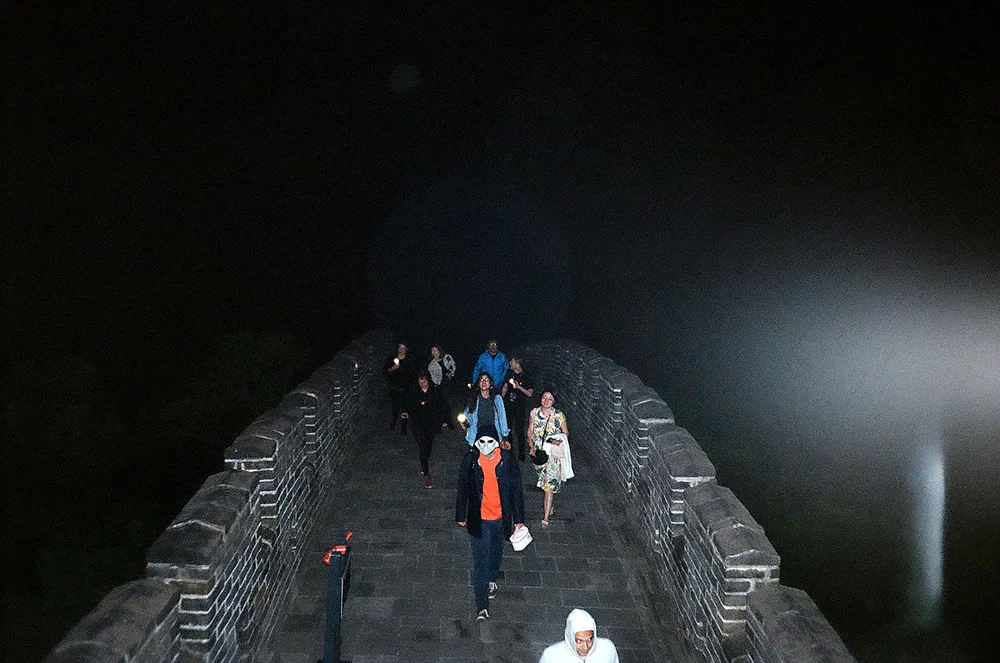
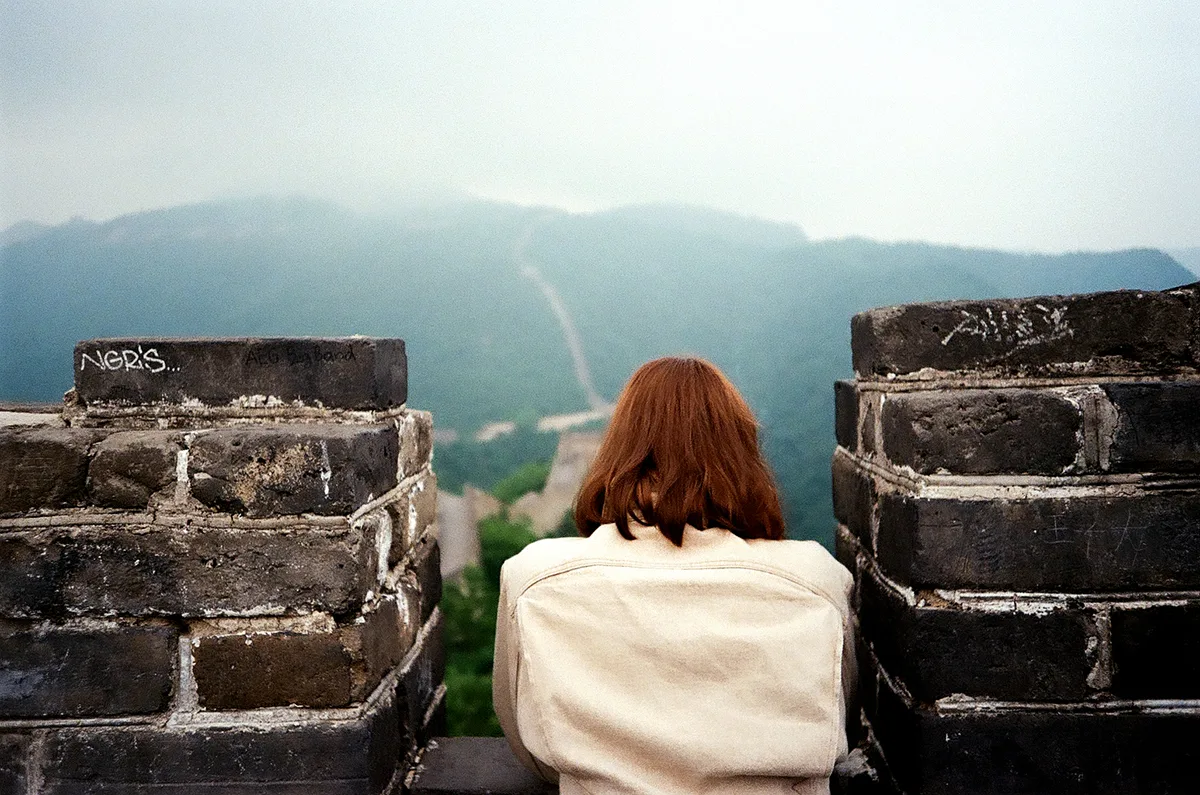
In May 2018, Nina Kraviz became the first international DJ to play an official set on the Great Wall of China. Josh Feola went to see her historic sunrise set, and looks at how techno is taking hold in China’s complicated creative culture. Photos by Frankie Casillo.
As dawn broke over Mutianyu, one of the best-kept sections of the Great Wall of China, a group of diehard techno fans somehow managed to stay on their feet. It was a miraculous feat of endurance for some, who’d spent the day partying at the Great Wall Festival, an outdoor rave held at a campsite an hour’s drive away.
Oddly, the festival kicks off with a 5km run along the Wall itself, so it really was a long day for many.
The sparse group who made it to sunrise was treated to the misty early morning light, as well as an exhilarating set from Russian producer Nina Kraviz.
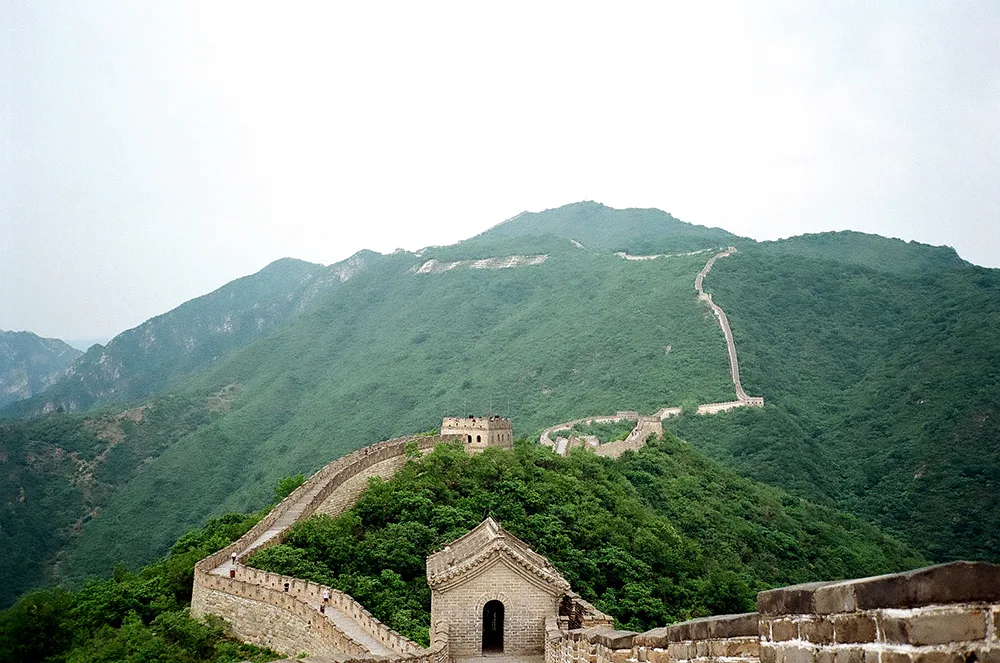
She made history with her live-streamed performance atop one of the Great Wall’s iconic watchtowers. A special arrangement had been made with Mutianyu’s cable car operators, who arranged for the select group of 30 to make the long ascent to the top of the Wall under the pitch black sky.
Nina then rolled out a set of contemplative, deep techno as the sun came up over the mountains to reveal the Great Wall — completely empty of tourists given the early hour — stretching as far as the eye could see beyond her ad hoc DJ booth.
“The plan was to create a bit of a psychedelic, mystical vibe,” says Nina, a highly in-demand talent who was heading to a gig in Estonia and then a North American tour after her appearance in China.
Though her record label трип is known for organizing parties in exotic locales, including two cave raves in Iceland, Nina says that her sunrise set on the watchtower ranks among her all-time most interesting performance venues.
And although she doesn’t really do nerves – “I focus on what excites me at the moment, playing certain music in a certain setting, so it gives very little time for expectations,” – it’s the combination of the time, the place and the crowd that defines her approach.
“The reaction of people is a part of this experience, because there’s no music or musical ideas without a listener, even if it’s just an imaginary one,” she says.

Nina Kraviz was not the first foreign artist to perform on the Great Wall of China, however. Irish band The Chieftans claimed that honor when they were invited by the Chinese government in 1983, five years after China began its official process of opening its economy to the outside world.
As deals flooded in, canny entrepreneurs sensed an opportunity in the cultural space – in 1985, Wham! took a now-famous photo on the Great Wall when they became the first Western pop band to perform in China.
The first music festival on the Wall came later, when Michael Vonplon, a Swiss expat credited with launching the ancient-China-meets-contemporary-dance-music format, organized the inaugural Great Wall Festival in 1998.
Since then, music on the Wall has been subject to the vicissitudes of government attitudes towards the influx of Western culture, and the less-than-respectful behavior that can sometimes accompany it. In 2002, the “first wave” of Great Wall festivals came to an end after photos of foreigners urinating off the side of the monument circulated online, according to Miao Wong, a central figure of the Beijing dance music scene.
The festivals were banned for a few years, but have come back in different forms and with different organizers since 2011, when Fatboy Slim headlined a festival at (but not on) Badaling, one of the Wall’s most touristic spots.
There’s no music or musical ideas without a listener, even if it’s just an imaginary one.
In a way, the history of festivals on the Great Wall reflects larger patterns in shifting attitudes toward Western music and culture on the part of China’s ruling class. The last several years have seen an ideological clampdown on after-hours revelry, with multiple incidents of popular clubs in Beijing being raided by police administering random drug tests on partygoers.
Prior to her early morning set, Nina also had a headline evening slot at the Great Wall Festival, which was inexplicably shut down 70 minutes before the scheduled end time by local authorities.
Festival attendees were nonetheless able to enjoy their corner of cultural turf, despite uniformed intervention, sporadic rain, and overpriced festival food.
Jackie Zhang, a party promoter in Beijing who began his career as a music journalist, made the trek specifically to see Nina play, and wasn’t disappointed. “I’ve known her music for quite some time, but this is the first time I saw her perform,” he says. “Her music is very interesting, and very hard to predict, which I love so much.”
Despite the difficulties faced in his line of work, Jackie is optimistic about the growth of underground music culture in China. “Over the last ten years, there have been various kinds of music scenes in China, even hip hop now is a big thing. But I believe that techno music will be the trend in electronic music in China. I’m positive about it.”

Isabella Wang, COO of the Great Wall Festival and one of the key coordinators behind Nina’s sunrise set, was first introduced to techno by French friends in Beijing in 2014. “I gradually fell in love with this type of music and culture,” she says.
A lawyer by training, Isabella lives in Berlin, where she works in the aerospace industry and is currently organizing a panel connecting music and art with space exploration. She’s been with the current Great Wall Festival since it was founded by Steve Peng in 2016, and manages the festival’s artist booking and business development.
For this year’s edition, Isabella says the focus was placed on techno and house in an effort to attract an “audience into underground culture.” The organizers also funneled significant resources into the stage design, lining the performance area with 50 Terracotta Warrior replicas custom-made by elder craftsmen in Xi’an, an ancient Chinese capital 1,000 kilometers southwest of Beijing where the actual Warriors reside.
Two of these grim-faced statues — weighing in at 200 kilograms apiece — were lugged on top of the watchtower for the sunrise set, along with a sound system and generator.
We invited Nina especially because we knew when she stands on the Great Wall, she can represent female power on such a masculine location.
Bringing all these elements together was complicated, according to Isabella.
The specific tower the festival wanted to use is a favorite destination for Chinese officials entertaining visiting international leaders.
“The authorities gave us a go after they knew that we really wanted to promote traditional Chinese culture and Great Wall spirit to the world," she says. "Especially to the young people who would appreciate it if we can be more innovative in introducing it to them."
At the same time as it nodded to the past, Nina’s performance was also an indicator of the future of electronic music in China. Both her evening and sunrise sets opened with a zither-laced techno track by Shanghai/Taipei-based producer Tzusing, who has built a strong international following on the strength of a series of releases on Brooklyn label L.I.E.S. that have put the Chinese scene on the global map in a way it hasn’t been before.
Isabella says booking Nina wasn’t only a chance to introduce the Russian artist to her Chinese fans, but also a statement of empowerment. “We invited Nina especially because we knew that when she stands on the Great Wall, she can represent female power on such a masculine location, and she can communicate with the world with her beautiful, exquisite music."
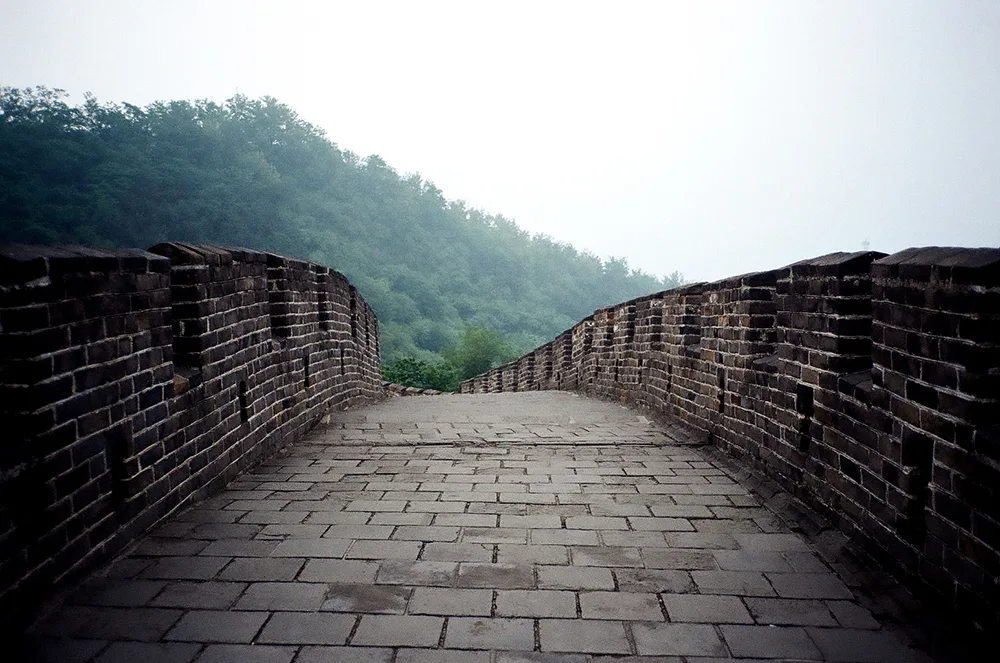
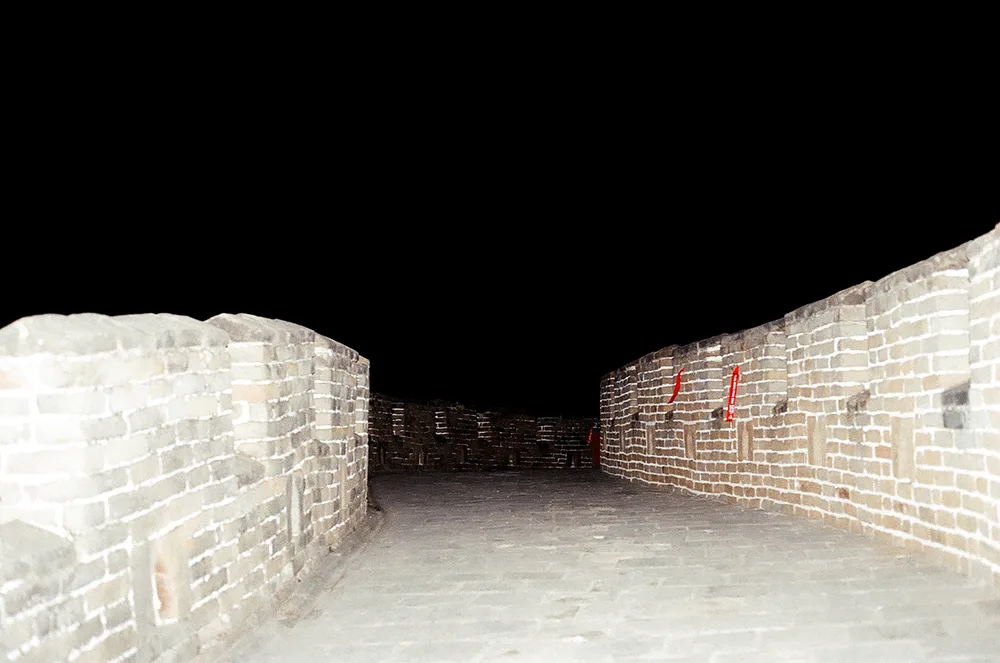
If the Wall was built as an ancient way to keep people out, Nina Kraviz’s sunrise set on its summit was orchestrated to pull people in. The whole thing was filmed by drone and live-streamed to the rest of the world over Facebook, a service that is blocked within China.
Nina – introduced to electronic music through late-night radio broadcasts in her hometown of Irkutsk, Siberia not long after the dissolution of the USSR – knows how technology shapes art and the ways we engage with it. “The new brains are different, and technology has played a huge role in it,” she says. “New brains want their music louder, they prefer songs to albums, and are most likely to appreciate every detail to evoke an instant reaction.”
In the end though, older technology had its way. The generator powering Nina’s performance ran out of gas just before 6am, cutting the set short. “I wanted to play this one special track called Rassvet which means sunrise in Russian,” she said afterwards. “It was made by Russian artist Buttechno, it’s this beautiful, beatless music with a children’s choir, and would have fit perfectly!”
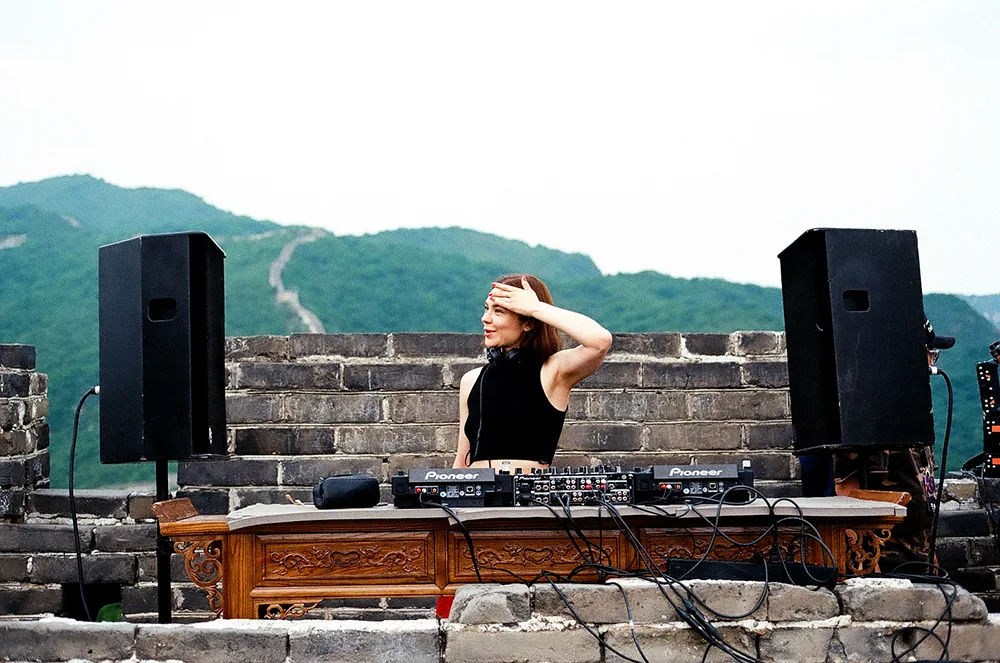
Nevertheless, her set achieved the “psychedelic, mystical vibe” she was aiming for, incorporating deep cuts of unreleased tracks from her label along with long, bass-heavy passages from UK producer Shackleton.
And as they made their way home, all those who were there agreed it was a one-off experience. “We’ll remember this for the rest of our lives,” one fan said. “Doing the walk of shame on the Great Wall of China.”


